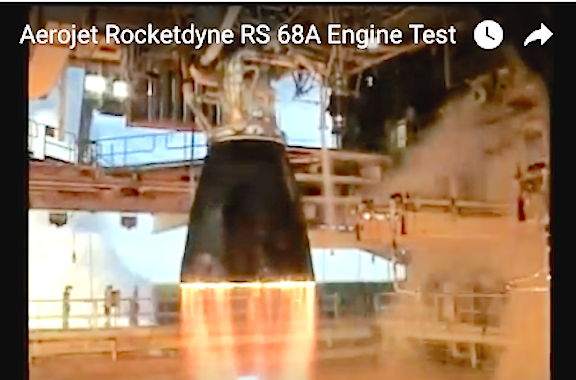
A successful launch requires the talents of numerous individuals and companies lending their expertise to the common goal... launch that satellite! Friday's early morning launch of the Air Force Space Command-6 (AFSPC-6) satellite was made possible with the assistance of Aerojet Rocketdyne, Inc., a subsidiary of Aerojet Rocketdyne Holdings, Inc. (NYSE:AJRD). At liftoff, a single RS-68A engine ignited to boost the Delta IV rocket off the pad, providing 702,000 pounds of lift-off thrust. After the upper stage separated from the launch vehicle, a single RL10B-2 engine ignited to provide 24,750 pounds of thrust to power the upper stage, using cryogenic liquid hydrogen and liquid oxygen propellants during its operation. The RS-68A is the world’s most powerful liquid-hydrogen/liquid-oxygen engine.
The huge RS-68A engine supported the successful launch of two Geosynchronous Space Situational Awareness Program (GSSAP) satellites into orbit to help detect and track space objects as part of the Air Force Space Command-6 (AFSPC-6) mission. The mission was launched from Cape Canaveral Air Force Station in Florida by a United Launch Alliance Delta IV rocket.

The RS-68A is the world’s most powerful liquid-hydrogen/liquid-oxygen engine.
Aerojet Rocketdyne's propulsion systems include:
- RS-68A booster engine
- RL10B-2 upper-stage engine
- 12 helium pressurant tanks
- 12 reaction control thrusters on the upper stage for roll, pitch, yaw and settling burns
Aerojet Rocketdyne CEO and President Eileen Drake stated, “In today’s world, it’s absolutely critical that our nation have the ability to monitor potential threats to military satellites operating in geosynchronous orbit above our planet. We are honored to provide reliable propulsion to make that possible.”
Rocketdyne's family of engines has a busy history that has now flown 33 commercial and government missions with 100 percent mission success.
The RL10B-2 engine is a liquid-fueled cryogenic rocket engine designed and developed from the RL10 family of upper-stage engines, which has accumulated one of the most impressive lists of accomplishments in the history of space propulsion. More than 470 RL10 engines have supported launches over the last 50 years, helping to place military, government and commercial satellites into orbit, and powering scientific space-probe missions to every planet in our solar system.
Twelve 9-lbf MR-106H Aerojet Rocketdyne monopropellant hydrazine thrusters packaged in four 3-engine MRM-106F modules on the Delta IV upper-stage provided roll, pitch and yaw control, as well as settling burns for the upper-stage. ARDÉ, a subsidiary of Aerojet Rocketdyne based in New Jersey, provided the pressure vessels on the first and second stages on the launch vehicle.
The twin spacecraft are the third and fourth satellites for the GSSAP. They will support U.S. Strategic Command space surveillance operations as a dedicated Space Surveillance Network sensor. The GSSAP also supports Joint Functional Component Command for Space tasking to collect space situational awareness data, allowing for more accurate tracking and characterization of man-made orbiting objects.

